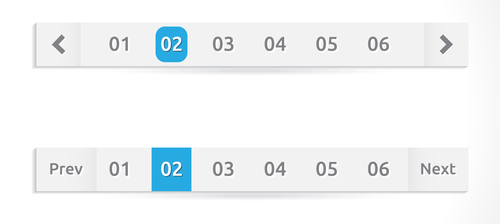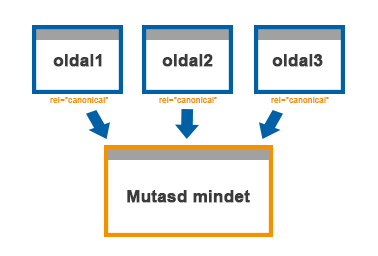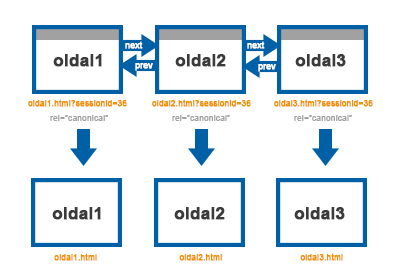Numbered pages vs. SEO | Weboptim
The problem with numbered pages can occur with any website... webshop, online newspapers, forums, etc..
What exactly are we talking about?
If the content of your website is longer than can fit on one page, you can talk about page scrolling, or numbered results pages. In the case of a webshop, you may see it when listing products, and on a news site, articles may be spread over several pages. SEO experts say that the existence of numbered pages can cause difficulties for Google when indexing websites.

Let's look at some potential problems:
- a limitations of web robots - when Google's robots scan a page, the direction and depth of their progress depends on a number of factors. If you have a large number of numbered pages, the chances of Google crawling through them all and getting to the last ones are significantly reduced.
- duplicate content - depending on the page layout, it is often the case that some elements appear on several pages with similar or identical content. In addition, you may often find that metadata is further added to numbered pages.
- little content - in situations where articles or product reviews are added to additional pages, there is a risk that the page may not provide enough original content for indexing. There is also the risk that such sites may be penalised by the Panda algorithm for having too low a content-to-advertisement ratio...
How to manage all this?
It is best to think about the issue of numbered pages when designing the site. When designing your site, you can reduce the numbering of pages by following these tips:
- increase the categories number - this reduces the depth of numbering
- increase the products displayed per page number of pages - also reduces the number of pages
- from the front page link for each additional numbered page
We have 3 weapons to solve the problem of numbered pages:
1. Remove additional pages from indexing
If you do not have the benefit of having such content indexed and searchable, the easiest way to
<meta name=”robots” content=”noindex,follow”>
tag on all pages except the first one. A Follow attribute is needed because it transfers the strength of links to numbered pages to the first indexed page.
Benefits:
- the least complicated solution
- ideal in situations where there is no particular logical reason to index numbered pages.
Disadvantages:
- solves page numbering problems, but also stops indexing pages.
2. "Show all" page and Rel="canonical" setting
For numbered pages, Google prefers to use "Show me mindet" page, which displays all products on one page. When creating such a page, place a rel="canonical" element, which is the "Show me" points to the side, like this:
<link rel=”canonical” href=”http://www.proba.hu/mutasd-mindet-oldal”/>
This will tell Google that each numbered page in the "Show me" and that queries are handled as part of the "Show me" to take users back to the page. Google believes this is the best way to solve the problem of numbered pages.

Benefits:
- relative ease of implementation on the site
- Google says the best solution
- all numbered pages in the "Show me" page represented in the search engines
- provides user-friendly navigation
Disadvantages:
- not a solution for numbered pages with massive or large images
- some businesses are unwilling or unable to implement the "Show me" page to list products
3. Rel="prev"/"next"
It is the most complex solution, but arguably the most versatile. A rel="prev" and "next" HTML attribute placement can be tricky.
The 2 properties essentially form a chain between the numbered pages. The chain starts with the first page. This is where we need to place the following code:
<link rel=”next” href=”http://www.proba.hu/oldal2.html”>
In the case of the second page "prev" and "next" elements, and so on... So we tell Google to treat the numbered pages as one entry and index them. Another important feature is that it can be used with a canonical tag.
Benefits:
- infinite flexibility
- solves the problem of page numbering "Show me" without using this page
- can be implemented with minor HTML changes
Disadvantages:
- can be complicated to implement
- requires proper enforcement for an efficient chain
Advanced concepts
Benchmark selection
Before making any changes, select a few numbered pages to determine the page depth to which the robots will scan the page. Once we have made the changes, we can use the server logs to see how the index-ratio has evolved.
AJAX and Java settings
In the case of web shops, you can set the way the user scrolls to the bottom of the page, automatic vacancy newer and newer products. So in this case, the numbered results pages disappear, leaving only an endless list. In addition to the numbered pages, this is also a benefit for the user experience.
Relevance signals: "Show all" page vs. rel="prev"/"next"
We are in the fortunate position of being able to choose which one we want to use. Even if we know that Google is the "Show me" solution is preferred, there are cases where the rel="prev"/"next" is much more practical to use.

Both solutions ensure the strength of inbound links on pages that appear in search queries. A "Show me" view is strengthened by the canonical links pointing to it, but the page ranked in the chain also inherits the strength of the links by Google indexing the sequence as a page.
But what about the other with relevance signs (title, description, unique URl, H1, etc..) that also affect the ranking of the page?
We know that the effectiveness of canonisation in relation to these elements is questionable. But if the "prev"/"next" attributes, which include the unique address and URL, every page has a chance of ranking well. This is of course not a consideration for product or category pages with similar content. No unique relevance factor page1.html and page2.html between, there is no ranking advantage "dress1″ with "dress2" Opposite.
What happens at this time?
The truth is that no one knows for sure how Google handles the "prev"/"next" attribute within the indexing. However, if we know at least in some cases that the first page appears in a search, then surely the URL, address and other factors will still play some role in the queries.
Parameters and rel="prev"/"next"
"Prev"/"next" When using this, you can set the numbered URL to contain a parameter that does not change the content of the page, only a unique session ID. We can specify that Google robots should not map pages that use URL parameters, but what if we want to preserve the strength of the links that come from them?
This is possible by simultaneously "prev"/"next" and canonical elements are also used.

First, we need to make sure that all "prev"/"next" numbered page in a series uses the same parameter, for example page1.html?sessionid=36 .
Second, all parameterized URLs canonicalise for the non-parameterized URL version.
Filtered content and "prev"/"next"
Now comes the case where we work with parameters that filter the content within the numbered pages. For example, products are listed using a brand filter:
http://www.proba.hu/oldal1.html?brand=nike
In this case, all pages carry this variable forward: http://www.proba.hu/oldal2.html?brand=nike , etc...
If you think it's valuable to have all filtered product types included in Google's indexing, it's best to create a separate numbered page for each brand filter. We don't need to use canonicalization because the content will be unique to the parameter.
Selected content and "prev"/"next"
The last type of parameterized URL type, when you see content sorted in a queue. It is found on blog and forum-type sites, but is also common on web stores. For example:
http://www.proba.hu/oldal1.html?order=older
http://www.proba.hu/oldal1.html?order=more recent
We can resolve the situation by using both the newer and older filtering "prev"/"next" parameter, but if we do this, Google will probably see it as a duplicate series with the same content. After all, the only difference between the 2 numbered sets of pages is the the order in which content is displayed.
A good solution is therefore to create a single numbered sequence for Google indexing and exclude the alternative sequence from indexing. This can be easily done with Webmaster tools with the help of. It may seem complicated at first, but it's easy to manage if you deal with each numbered page separately and apply the right rules in the right place.
So we can see that there are several ways to solve the problem of numbered pages. But it will always depend on the situation which solution is the most appropriate.
Source: ayima.com